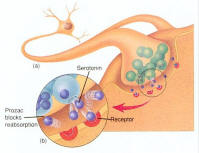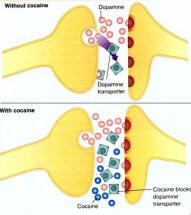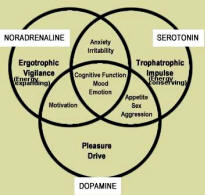Neurology Anatomy Physiology
December 14, 2021
Contents
neurons and Nervesneurotransmitter
The Brain & Spinal Cord
Cranial Nerves
Peripheral Nervous System
Autonomic Nervous System
Senses: Eye diagrams, Hearing, Smell, Taste, Taste & Tongue Sensation, Balance
Memory , Memory types, Creation of Memory
Higher Functions
Altered States
Neurotransmitters
 manipulations and abuses. Natural
neuromodulators can aid the release or inhibit the reabsorption of neurotransmitters; still others delay the breakdown after reabsorption, leaving them in the tip to be
reused by the next nerve impulse. Mood, pleasure, pain, and
other mental states are determined by particular groups of neurons in the brain that use special sets of neurotransmitters and neuromodulators. For example, mood is
strongly influenced by the neurotransmitter serotonin. It is believed that depression results from a shortage of serotonin. It is difficult to treat depression directly with
serotonin because the chemical has too many other side effects. However, depression can be successfully treated with drugs that act as serotornin neuromodulators (Figure
02d). Prozac, the
manipulations and abuses. Natural
neuromodulators can aid the release or inhibit the reabsorption of neurotransmitters; still others delay the breakdown after reabsorption, leaving them in the tip to be
reused by the next nerve impulse. Mood, pleasure, pain, and
other mental states are determined by particular groups of neurons in the brain that use special sets of neurotransmitters and neuromodulators. For example, mood is
strongly influenced by the neurotransmitter serotonin. It is believed that depression results from a shortage of serotonin. It is difficult to treat depression directly with
serotonin because the chemical has too many other side effects. However, depression can be successfully treated with drugs that act as serotornin neuromodulators (Figure
02d). Prozac, the Figure 02d Neuromodulator
[view large image]
world's top-selling antidepressant, inhibits the reabsorption of serotonin, increasing the amount in the synapse by slowing down its removal.-
Go to brain section
Powered by cidpusa.org
 When a neuron cell is exposed to a neurotransmitter for a prolonged period, it tends to lose its ability to respond to the stimulus with its original
intensity. This is known as habituation, which is the result of the cell producing fewer receptors for that particular neurotransmitter. If someone takes a drug that acts as a
neuromodulator (such as cocaine), which causes abnormally large amounts of neurotransmitter (dopamine in this case, Figure 02e) to remain in the synapses for long periods of
time, it would generate more pleasure messages. Such action reduces the number of receptors in the neuron. Next time a higher dosage is required to maintain the pleasurable
sensation. The result is addiction. Cocaine is a stimulant discovered in the mid-1800s. Many physicians at first considered it a miracle drug, prescribing it for all sorts
of physical and mental ailments; it was even added to soft drinks. Today United States law forbids the importation, manufacture, and use of cocaine for nonmedical purposes, and
even the medical use is extremely limited.
When a neuron cell is exposed to a neurotransmitter for a prolonged period, it tends to lose its ability to respond to the stimulus with its original
intensity. This is known as habituation, which is the result of the cell producing fewer receptors for that particular neurotransmitter. If someone takes a drug that acts as a
neuromodulator (such as cocaine), which causes abnormally large amounts of neurotransmitter (dopamine in this case, Figure 02e) to remain in the synapses for long periods of
time, it would generate more pleasure messages. Such action reduces the number of receptors in the neuron. Next time a higher dosage is required to maintain the pleasurable
sensation. The result is addiction. Cocaine is a stimulant discovered in the mid-1800s. Many physicians at first considered it a miracle drug, prescribing it for all sorts
of physical and mental ailments; it was even added to soft drinks. Today United States law forbids the importation, manufacture, and use of cocaine for nonmedical purposes, and
even the medical use is extremely limited.
Figure 02e Drug Addiction
[view large image]

Table 01 summarizes the properties of some important neurotransmitters.